The Use of Twelve-Tone Technique in Chinese Musi...
七、The Use of Twelve-Tone Technique in Chinese Musical Composition
Many Chinese composers, in the past decade, have combined twelve-tone technique with national style in their compositions, producing twelv-tone works with Chinese characteristics. Some have enriched their works with pentatonic characteristics common to much Chinese traditional mu⁃sic;some have used elements of folk music, Chinese traditional dramatic music, and folk percussion;others have serialized traditional elements of rhythm and timbre. The result is a different type of music from that of Western composers. In this article, I will discuss some effective ways Chi⁃nese composers use these in their works.
One of the most effective ways to endow a twelve-tone work with a pentatonic nature is to design a series(basic set)with pentatonic charac⁃teristics in the structure. In such a series the interval between a note and its neighbors must be within the limits of a major second, a minor third, a major third, a perfect fourth, and their inversions, and must avoid the emergence of semitones and tritones. The following two examples show the series used in Luo Zhong-Rong’s song“Picking Lotus Flowers at the Riv⁃erside”and Lu Shi-Lin’s film score“A Family of Red-crowned Crane”.
Example1a is a series of prime form(P);there are no semitones or tritones in any pair of contiguous notes. The first five notes form a penta⁃tonic scale(E Gong),[1]the last seven, a major scale(B-flat);E and B-flat are a tritone apart, like the black and white keys on the piano (see Ex.1b).
Ex.1. Luo Zhong-Rong(罗忠镕):“Picking Lotus Flowers at the Riv-erside”

The series in Example 2 consists of three tetrachords.Thy are pitch-class(pc)set with pentatonic nature 4-23 and 4-22. Sometime the inter⁃val of semitone and tritone may asist between pentatonic segments, but within, the pentatonic character is maintained.
Ex.2. Lu Shi-Lin(芦世林):“A Family of Red-crowned Crane”

Wang Jian-zhong’s“Pastorale”repeats a pentatonic motive con⁃stantly in various forms(Ex.3).Here, The first three notes of the series , D-sharp, F-sharp, and G-sharp, form a pure pentatonic set (pc set 3-7) which takes the role of motive, The melody of the first phrase(mm.1-3) repeats this motive several times(see mark under motive in Ex. 3). The second half of this phrase is in three part harmony. It is noteworthy that the upper voice is written as a nonlinear segment of the series, but it is still motivic in formation. In the second phrase(mm.4-6), the motive is repeated more frequently in the melodic line, but the upper voice in the three part harmony is not expressed strictly as the motive. The intervals are extended.
In the followingdevelopment(Ex. 3b), the motive is repeated further in various forms(I, R, RI, and their transpositions), constituting a series of variants(Ex.3c)which consists of the motive only. By this means, the composer saturates the piece with pentatonic elements.
Ex.3. Wang Jian-Zhong(王建中):Five Pieces for Piano, No. 1,”Pas-torale”
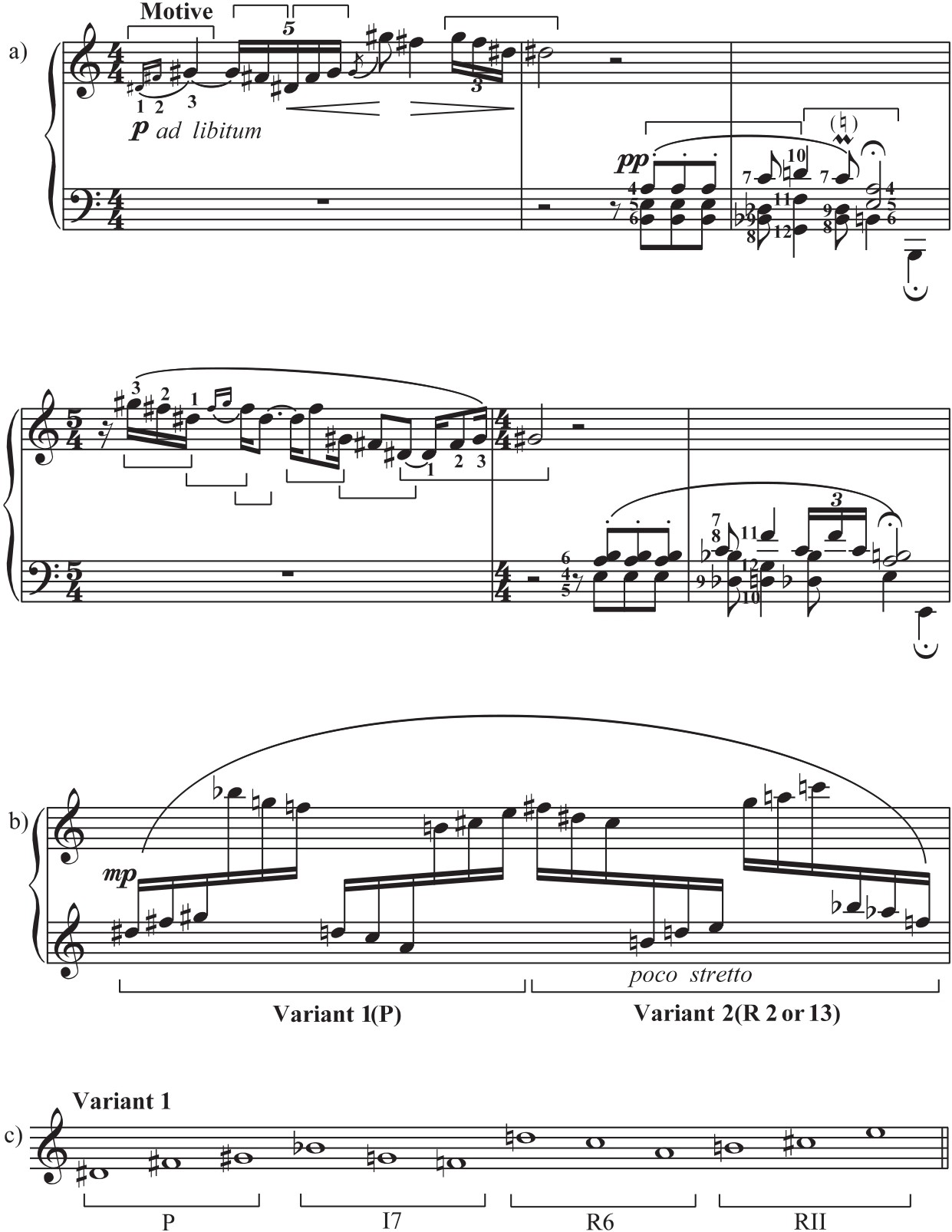
Luo Zhong-Rong has used another method for the same purpose. In his song“Evening”, the soprano and left-hand accompaniment employ the material from the series consisting of pentatonic set 4-22 and 4-23, with an additional free part of pentatonic ostinato for the right hand. As a result, the pentatonic style has been strengthened and a subtle effect of polymeter and dreamy atmosphere is derived from the overlapping of the two elements, the pentatonic ostinato and the twelve-tone pattern(Ex.4;text:I said that all the little chrysanthemums had closed their sleepyeyes.)
Ex.4. Luo Zhong-Rong(罗忠镕):“Evening”(for soprano and piano)
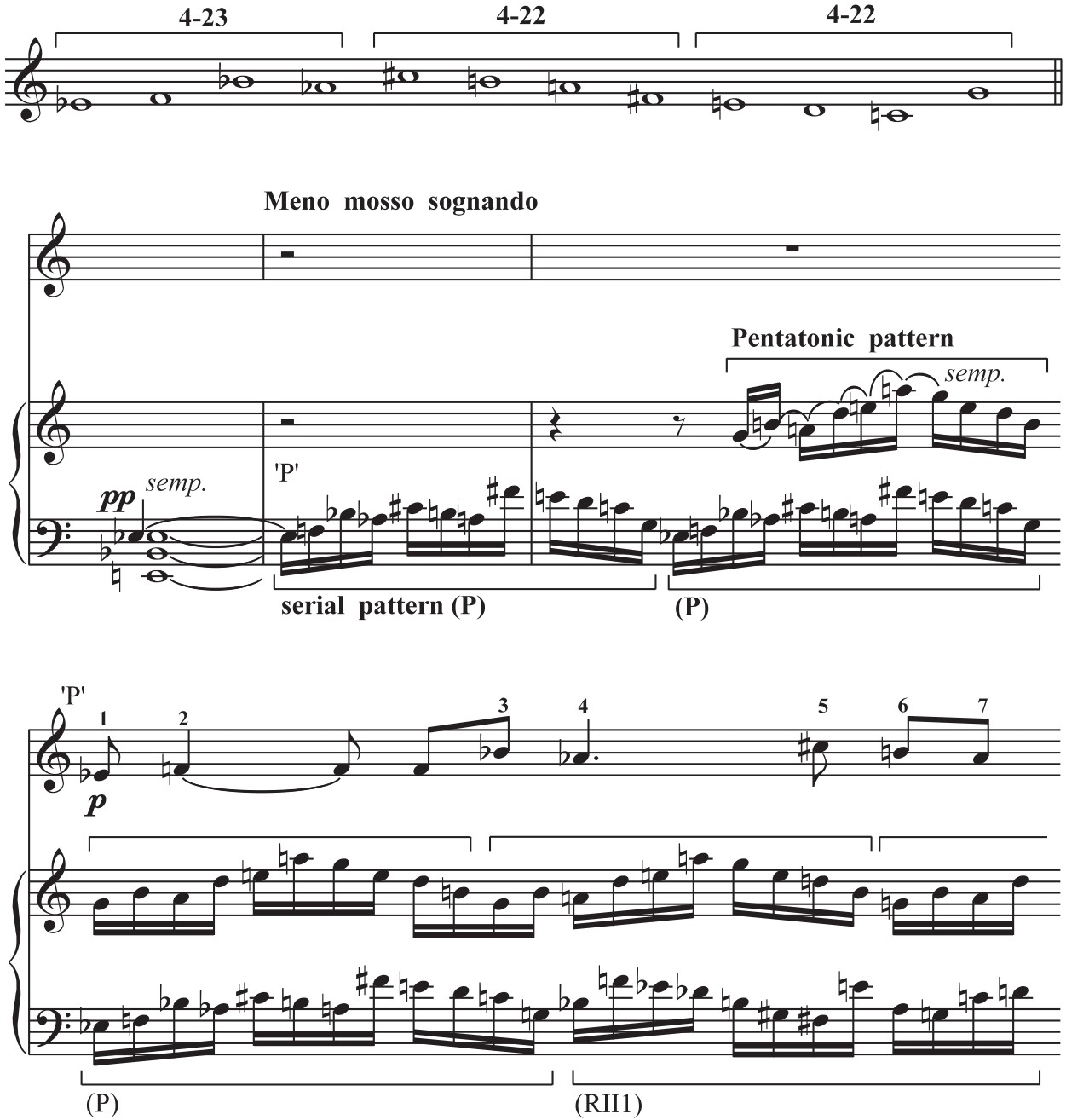
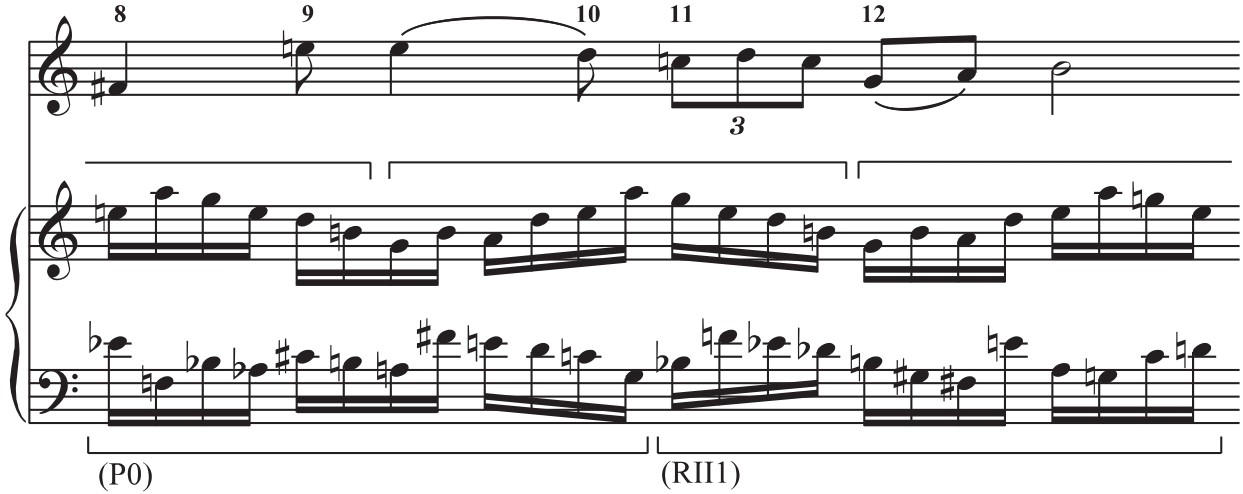
The emphasis on pentatonic elements, as shown above, is an effective way to endow twelv-tone music with Chinese stylistic characteristics, but it is not the only way. Some composers have incorporated other elements of folk music into their works. The following example shows a wonderful melody in Li Bao-shu’s“Traumerei of Jiuzhai Gou”in which the first phrase is a tonal melody in Tibetan folk-song style, and the second phrase is a twelve-tone melody. Because the two pentatonic motives are similar, they conbine smoothly into a harmornious unity(Ex.5). Such twelve-tone music is easily understood.
Ex.5. Li Bao-Shu(李宝树):“Träumerei of Jiuzhai-Gou”
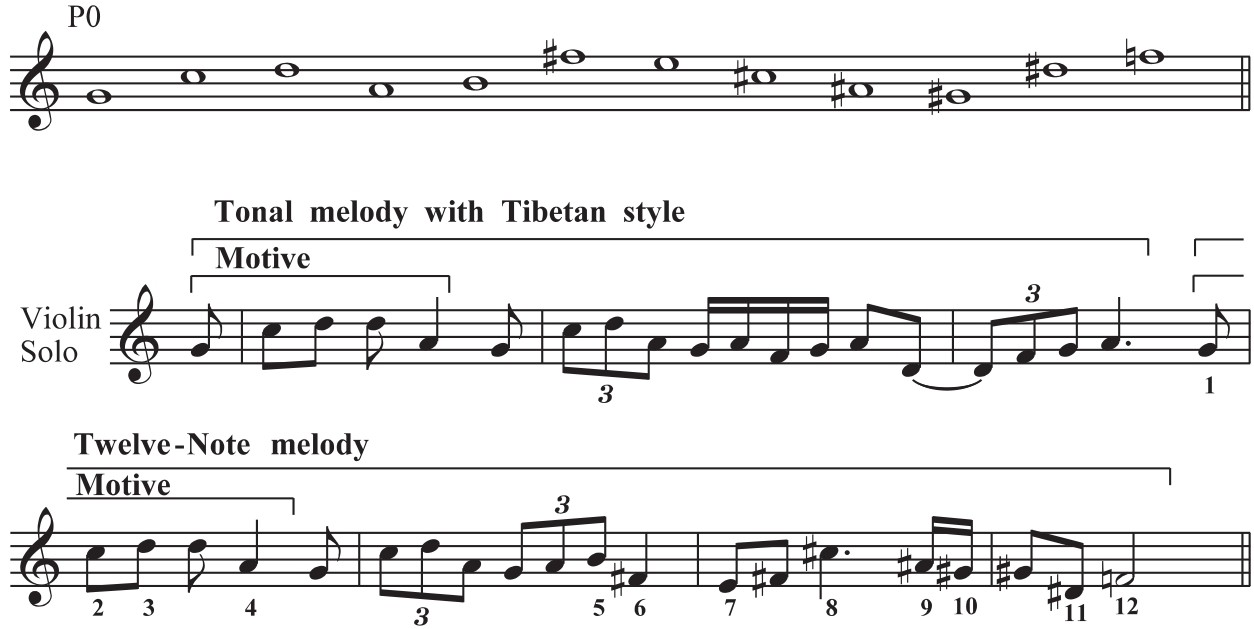
In the symphonic suite Impressions of Taihang Mountain, Wang Xi-lin similarly combines a tonal“Ku-qiang”(painful tune,哭腔)[2]with an atonal twelve-tone melody(Ex. 6). After a dominant seventh, which con⁃tains its resolution note,“C”, the bassoon plays a painful-tune-like melo⁃dy in C shang which is without meter and contains a brief modulation to C-flat. At the end of this phrase, G moves to C through a flatted fifth. The consequent phrase is in 4/4 meter with the cello and double bass playing a twelve tone melody an octave apart, giving a low and deep internal strength. The impression on the listener is both“sorrowful”and“heroic”;the development of the material feels quite natural.
Ex.6 Wang Xi-lin(王西麟):“A Dilapidated Tombstone”, fourth movement of Impressions of Taihang Mountain
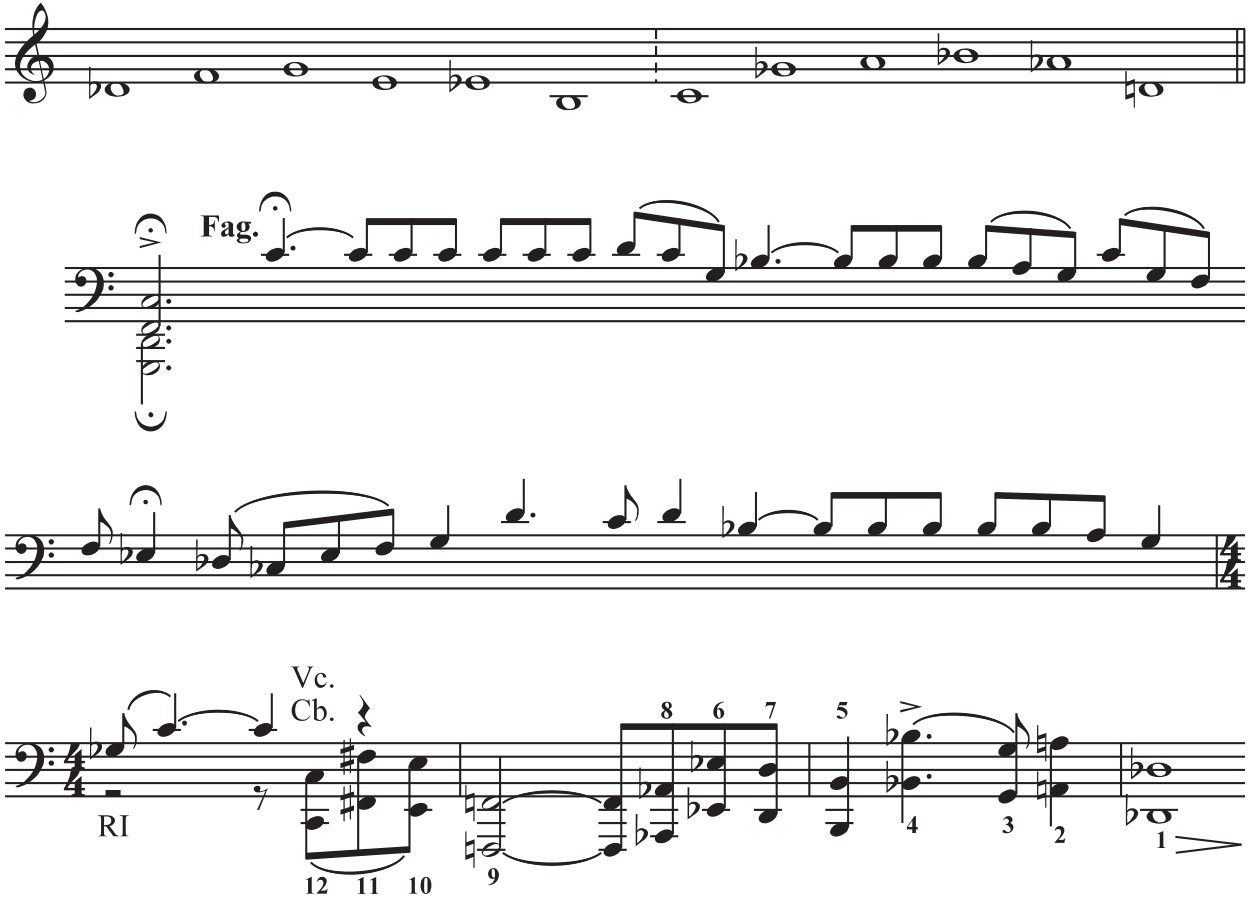
Zhou Jin-Min’s Scherzo from his Quinted for Piano and Strings also uses elements of folk music with a special flavor of Hubei. However, the composer has employed still another technique to achieve his goal. One of the characteristics of Hubei folk song is what might be called“three-note tunes”, in which a melodic fragment may consist of a major second and a perfect fourth only (Ex.7). The composer based his series on a“three note tune”, a cell of pc set 3-9(see Ex.8). In such a series, a and b, c and d, are related by inversion, and the first and second hexachords are similarly related. The structure is virtually symmetrical. The composer us⁃es these materials freely and imaginatively and does not always adhere the rules of serial writing.
Ex.7. Folk song of Hubei

The work consists of five main sections in arch form:
Introduction+A+B+C+B+A+Coda
The following are the themes of sections A and B(Ex. 8):
Ex.8. Zhou Jin-Min(周晋民):Scherzo(from Quintet for Piano and strings)

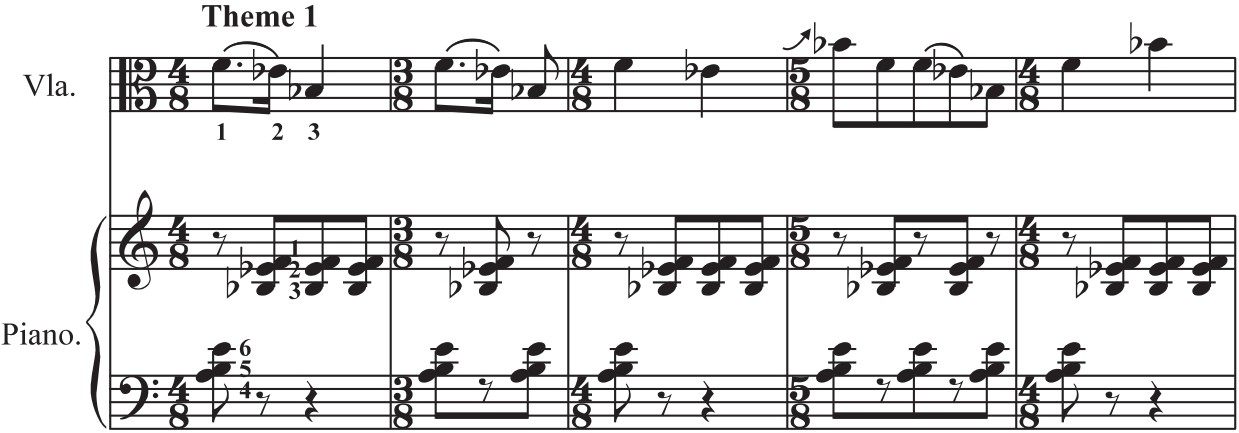
In theme 1 the viola plays a melody formed only by set“a”and is full of Hubei folk-song flavor. At the same time the piano accompaniment consists of set“a”and set“b”and creates a percussive effect. A bitonal effect is created because the two sets in different keys overlap, even though the theme consists of only six notes. Moreover, it uses alternate me⁃ters horizontally(4/8,3/8,4/8,5/8 and its circle), and this complicates the effect. This passage has both local flaver and contemporary style. The theme of section C is arranged differently(Ex.9)
Ex.9. Zhou Jin-min(周晋民):Scherzo

For the Harmonic background, the strings play two chords of fourths derived from c and d(D-G-C and G sharp-C sharp-F sharp). Above this background, the piano plays theme 3 in two octaves(Ex.9), using c and d again. These sets in different keys are combined in a melody and create a new chromatic style derived from the“three-note tune”.
It would seem that these two examples have deviated from the rules of Schoenberg, and one might reasonably ask,“Is it still twelve-tone mu⁃sic?”We must remember Schoenberg’s statement:“My works are twelve-tone composition, not twelve-tone composition.”[3]Sometimes to achieve the desired musical effect, it is necessary to deviate from the rules.
Chinese composers have made great efforts to seek out a national style, and have also attempted to strengthen the structural force of their works. Besides using twelve-tone methods, they have introduced serial principles into other aspects of music. In the piano solo“Series of Scene”Peng Zhi-Min uses a“Fibonacci-golden section”(F-G)[4]series to con⁃trol the rhythms and intertervals in this work(Ex.10).

Ex.10. Peng Zhi-Min(彭志敏):“Evening Dram”, from“Series of Scene”(for piano)

In the above example, lelf and right hands repeat pentatonic chords that form the first six notes of the twelve-tone series and are atritone apart. The accents appear according to the Fibonacci series, used in two different ways. The accents in the left hand are on repetitions 1,2,3,5,8. etc. Those in the right hand are spaced apart according to the same series. Because of the difference of cycles and the contrasts in registers, the music gives a rough effect in rhythm.
The following passage (Ex.11) is more complex.“F-G”controls three aspects at the same time: the trill in the left hand is divided into groups, the chord in the right hand increase in duration, and the largest in⁃terval class of each chord is still controlled by the series. The length of this composition is“1000×��”(1000 sixteenth notes), and the 618 th six⁃teenth note—the golden section point—emerges at the climax area.
Ex.11. Pen Zhi-Min(彭志敏):“Thumderbolt”, from“Series of Scene”
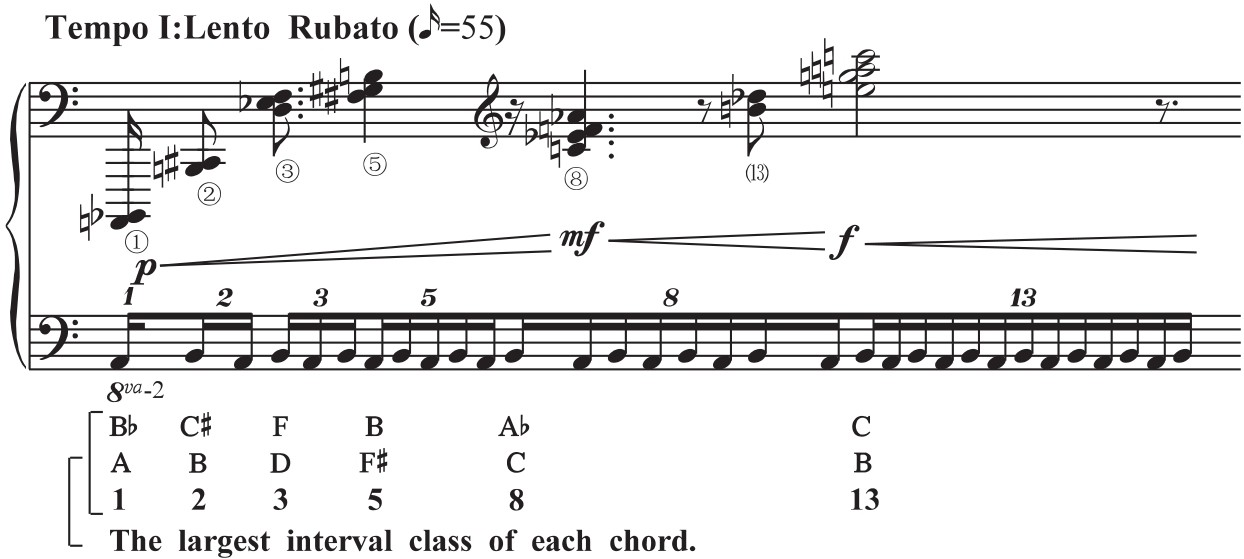
Luo Zhong-rong’s example belongs to another type. He discovered a rhythmic and timbre series in early Chinese folk percussion music called“Shifan Luogu”[5]and has combined them with a twelve-tone series. In his Second String Quartet of eight short movements, the second, fourth, and seventh movements are predominantly rhythmic, with melody playing a secondary role.“Shifan Luogu”uses a Luogu Pai(rhythm pattern)called“She Tuo-ke”(Snake Sheds It��s Skin).It consists of five units (see Fig.1), and each unit contain a pattern played four times“A,B,C,D”;it di⁃minishes successively from unit 1 to unit 5(4 × 4,4 × 3,4 × 2,4 × 1,4 × 1/2). Each pattern is decorated differently, enhancing the detail of rhythm with variety and distinguishing color. It forms a timbre series:“A”emphasizes col legno of first violin;“B”emphasizes arco of viola;“C”emphasizes Bartok pizzicato of second violin; and“D”emphasizes pizzicato of cello. For the purpose of decoration, some small figures are inserted between the different colors. Finally, in unit 5, the decoration of small figures is aban⁃doned and changes to pointillism. Example 12 shows a passage from units 4 and 5.
Fig.1. Rhythm in“She Tuo-Ke”
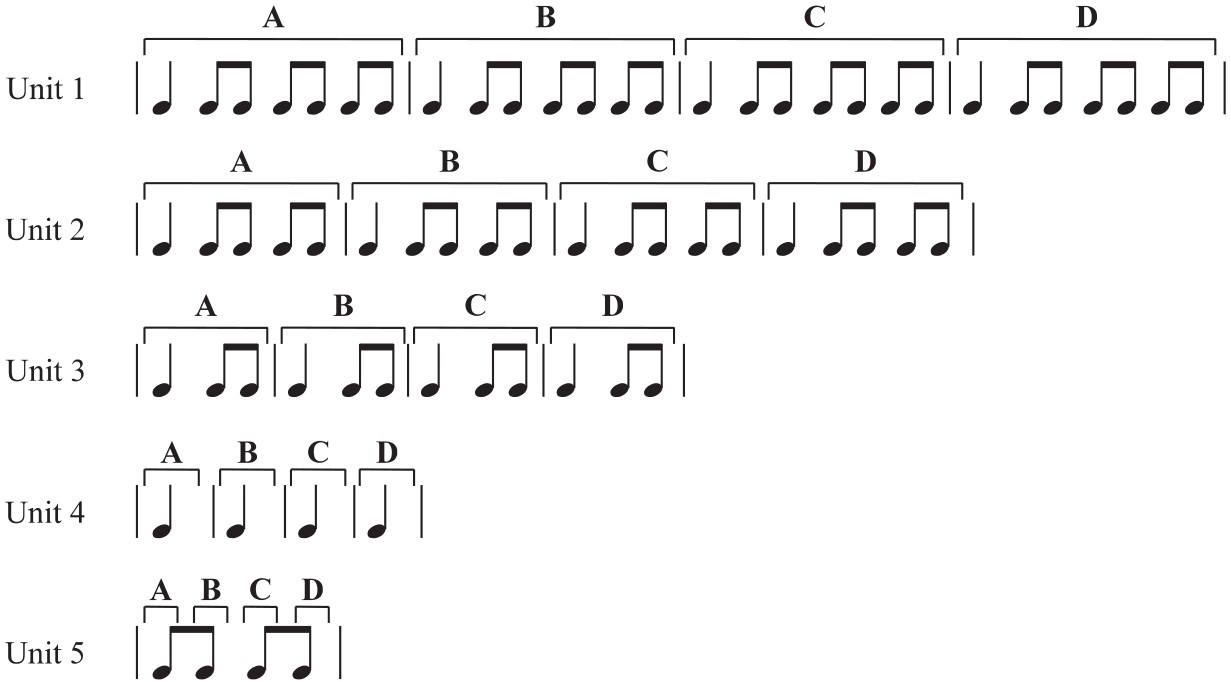
Ex.12. Luo Zhong-Rong(罗忠镕):Second String Quartet
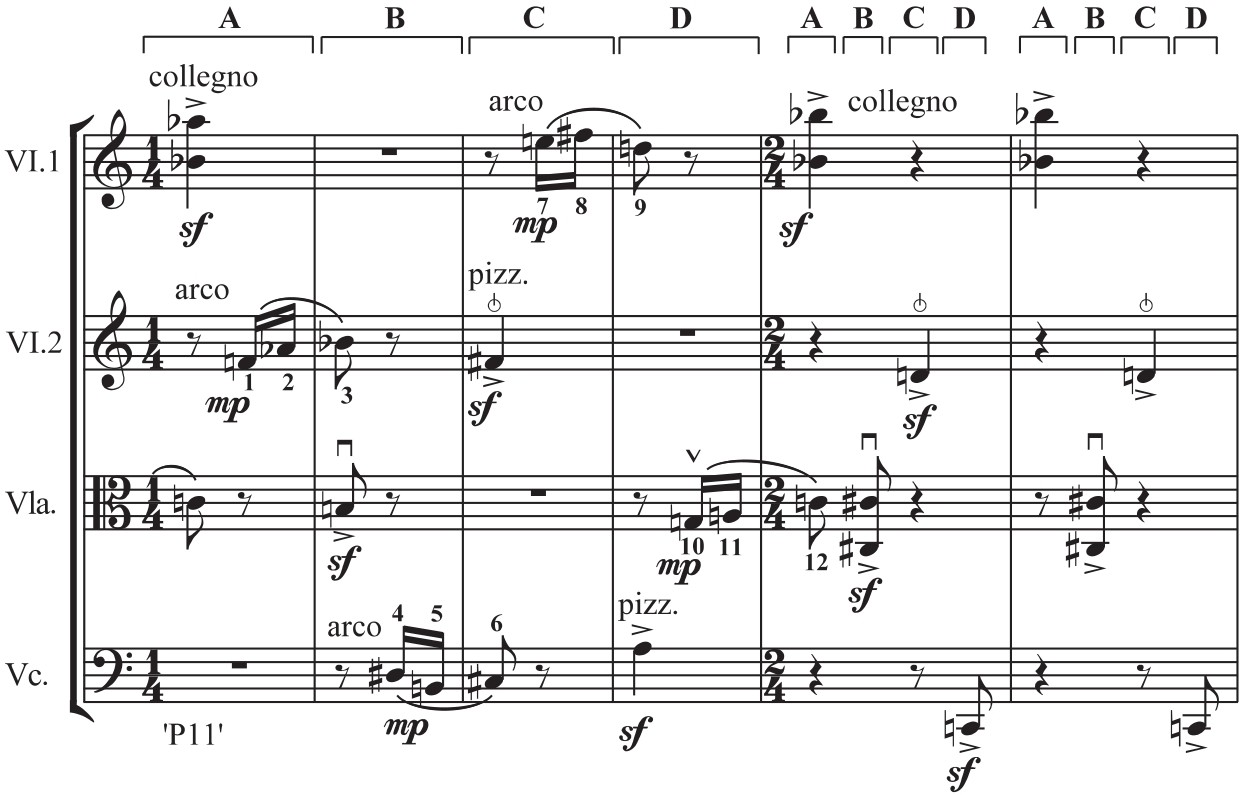
Chinese composers have used the techniques of Hauer as well as Schoenberg. In the Toccata for piano, Luo Zhong-Rong uses two tropes as the basic material. Example13 gives the beginning:
Ex. 13. Luo Zhong-Rong(罗忠镕):Toccata(Three Pieces for Pia-no, No. 1)
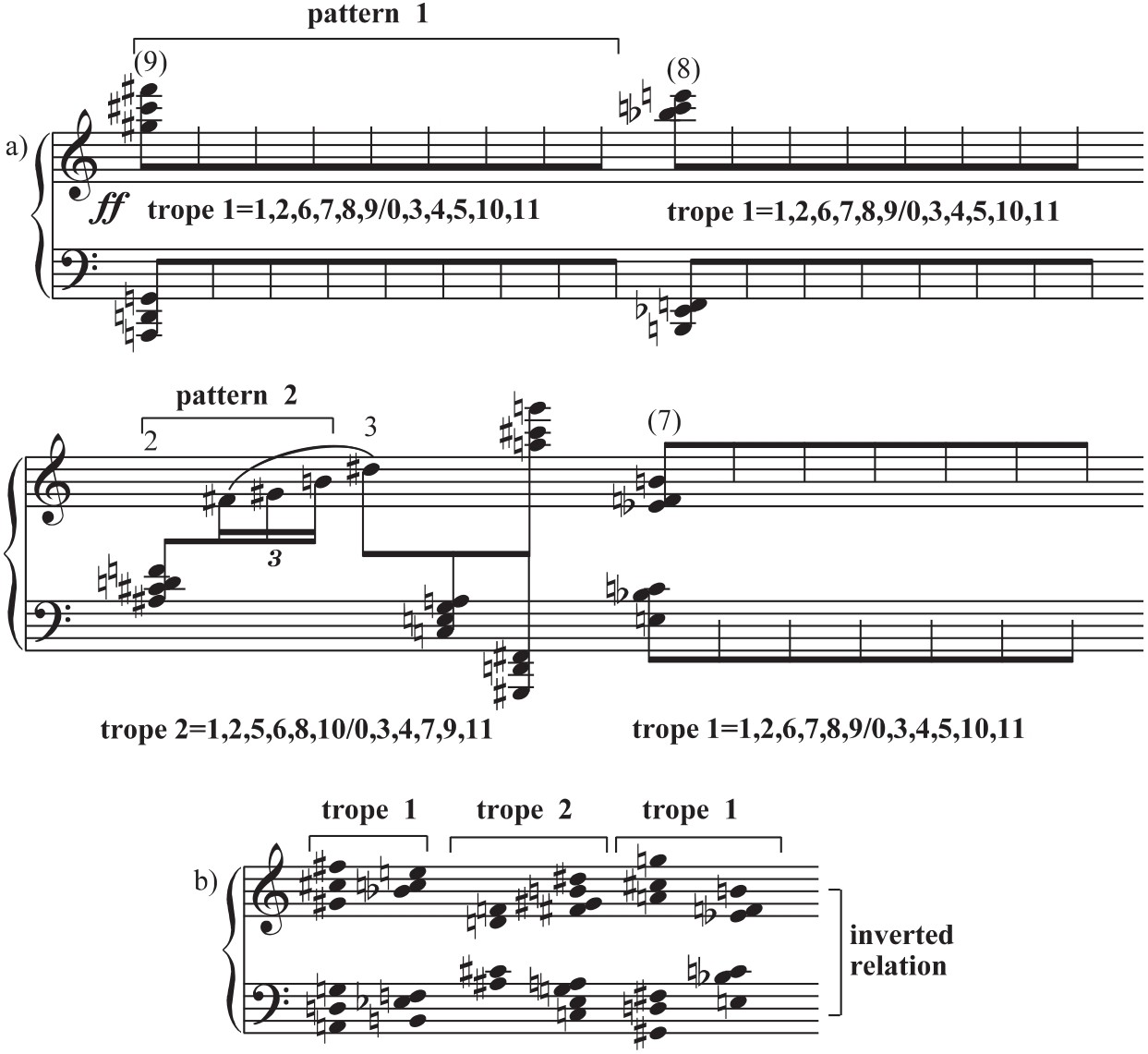
With respect to pitches, this work uses trope1 and trope 2 alternately, ar⁃ranged in various forms to keep the upper and lower parts in an inverted relationship (See Ex.13b). From the stand-point of rhythm, patterns 1 and 2 are used in turn(See Ex.13a).Thy are all based on the eighth note as the basic rhythmic unit. Pattern1 begins with nine units, followed by eight units, represented as“(9)+(8)”, and diminishes successively. Pat⁃tern 2 is the reverse;it begins with“2× ”followed by “3×
”followed by “3× ”,represent⁃ed as“2+3”, and increases successively. At the middle point the music becomes retrograde, a mirror structure in rhythm but not in pitch(Fig.2).
”,represent⁃ed as“2+3”, and increases successively. At the middle point the music becomes retrograde, a mirror structure in rhythm but not in pitch(Fig.2).
Fig.2.

In recent years the young composer Yang Heng-Zhan has turned to⁃ward a combination of the techniques of Schoenberg and Allen Forte’s theory concerning pitch-class and pitch-class set. The following discus⁃sion is concerned with his pieces for“Luoshu Tu”(《洛书图》)and“Dan Qu”(《但曲》).The composer’s inspiration is taken from the mathematics and music of ancient China.
“Luoshu Tu”, the magic square, consists of nine numerals. The sum of the three numerals vertically, horizontally, and diagonally is al⁃ways 15(Fig.3). The composer has arranged a nine-note series accord⁃ing to the numerals of the magic square (from left to right), taken ev⁃ery namber for an integer of pitch-class, and found the corresponding value of each note.

Fig.3.
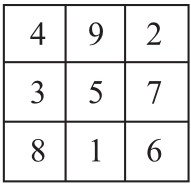
Through this method the theme of“Luoshu Tu”emerges (Ex.14). The theme is a direct translation from the cipher of“Luoshu Tu”, the nu⁃merals changed into notes by means of the medium of pitch-class. It is in⁃teresting that the theme has some pentatonic characteristics.
Ex.14. Yang Heng-Zhan(杨衡展):“Luoshu Tu”(for piano)
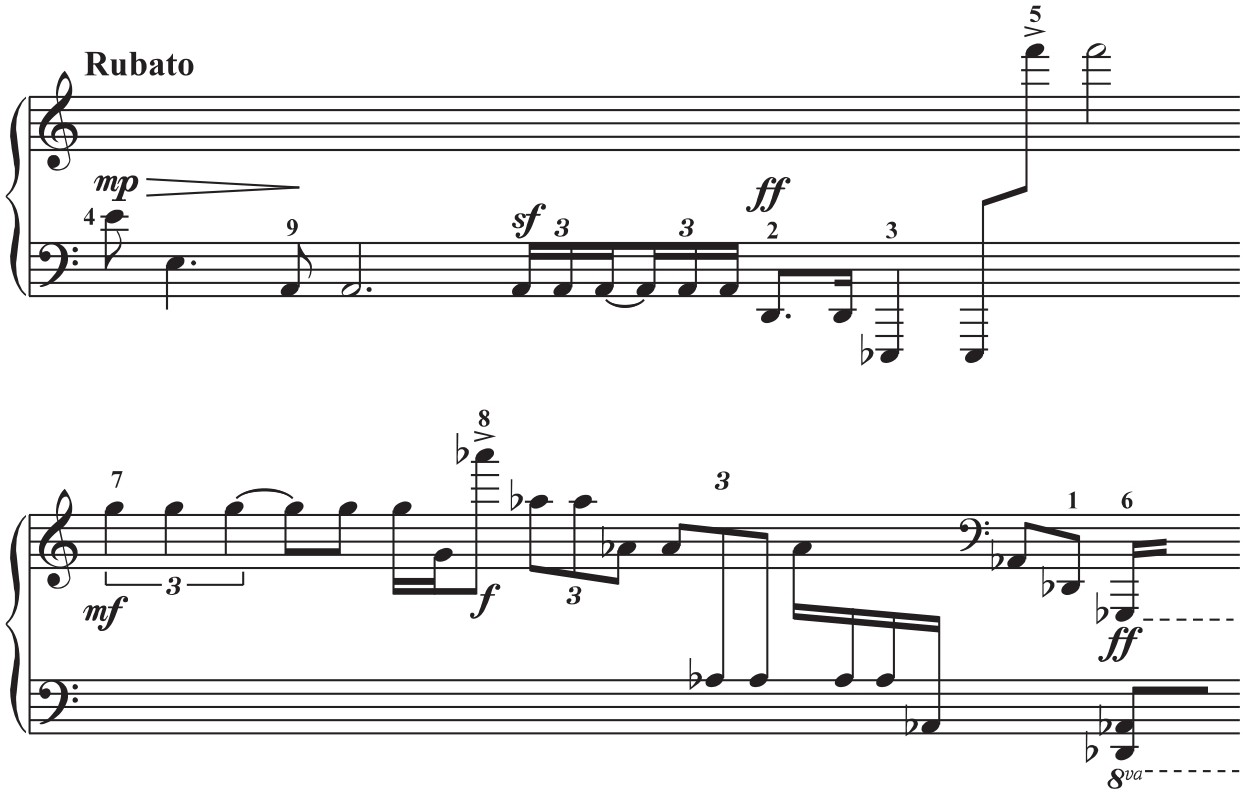
“Dan Qu”was highly evolved in Xianher Song(相和歌)during the Han Dynasty(206 B.C. to A.D.220), and consists of three parts.The com⁃poser has extracted two typical tunes—“do-re-sol”and“la-do-re”,i.e., pc set 3-9 and 3-7—as the motive in his series;he uses a tripartite prin⁃ciple in the larger form. The following example is a passage from the tran⁃sition between parts A and B. These two sets mentioned above are con⁃stantly stressed(Ex.15). The passage has three levels of texture;two out⁃er parts that are pc set 3-9 horizontally are in a semitonal relation;they are contrasted in register and played with different modes of touch. The in⁃ner parts contain three pairs of pc set vertically;they are all 4-23, with the two sets in each pair also in a semitonal relationship. Close examina⁃tion reveals a more complex structure than first appears.Pc set 3-7 and 3-9 are all contained twice in 4-23. In each part, every first and second note of all three pairs are made up of pc 3-9 together(see Fig.4).
Ex.15. Yang Heng-Zhan(杨衡展):“Dan Qu”(for piano)
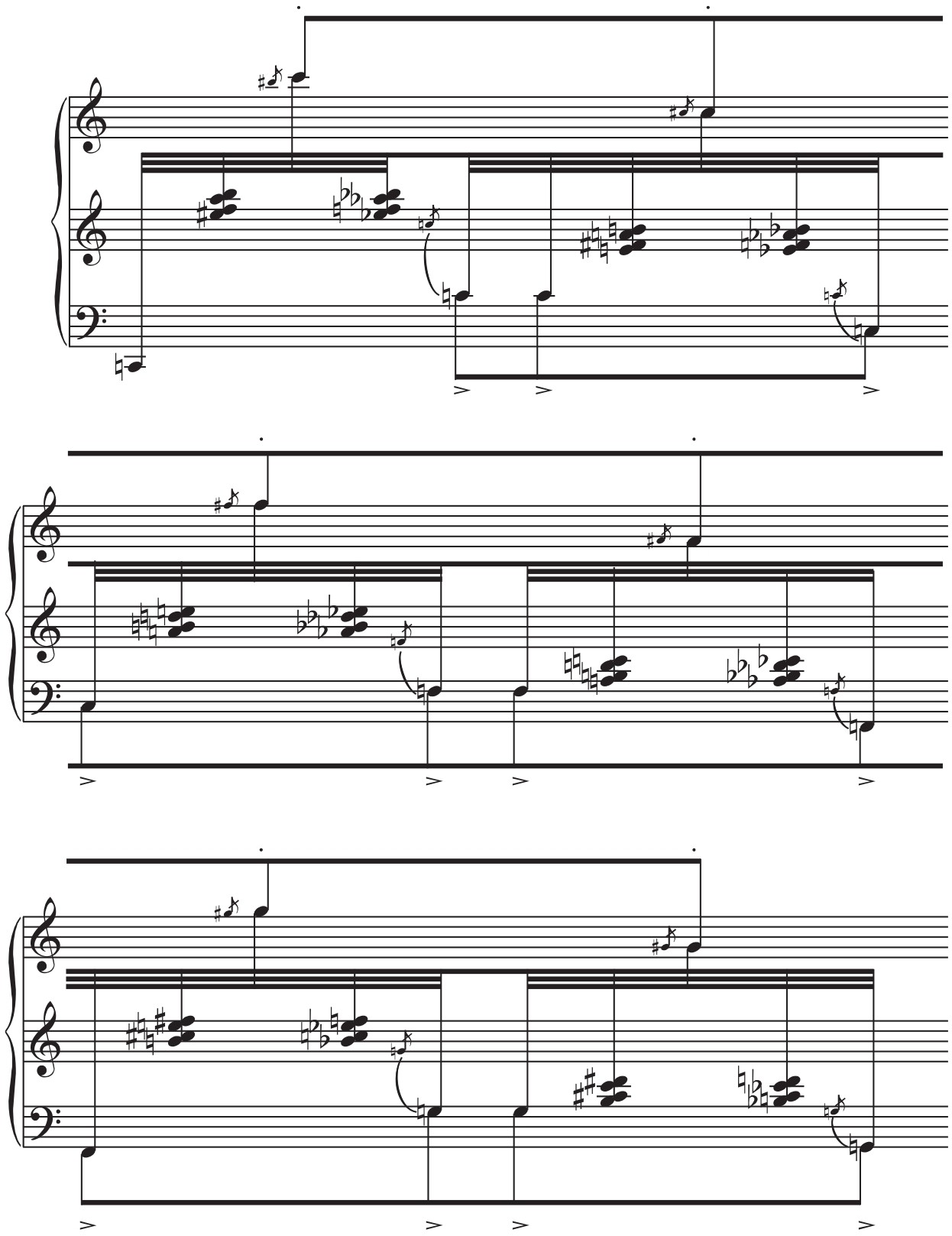
Fig.4.
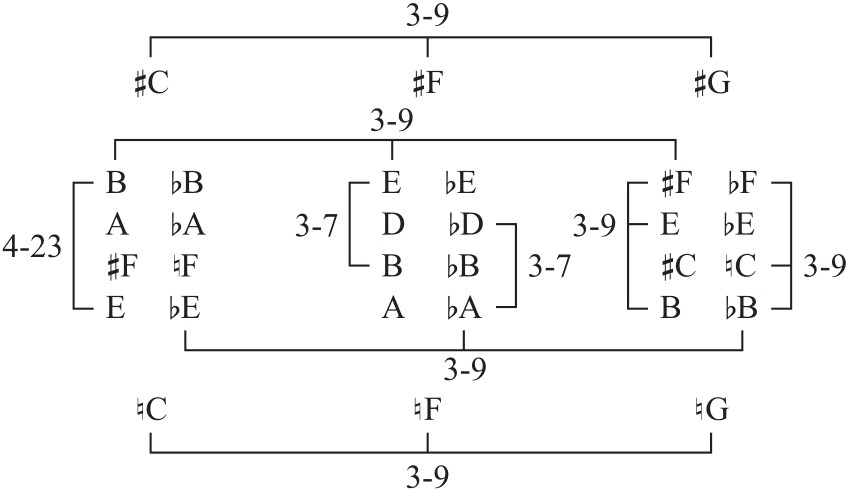
The composer calls this music“a solid geometric writing with penta⁃tonic set.”Although the three sets used in the above passage(3-7, 3-9, 4-23), all are pentatonic in structure, and there is a semitonal relation⁃ship which counteracts the lack of tension. The introduction of set think⁃ing is an effective means of strengthening the structural force in twelve-tone writing.
Although this discussion has involved only a few composers and only part of their works, it may perhaps the main lines that twelve-tone com⁃position is taking in China.
注 释
[1].The five tones of Chinese pentatonic scale are named Gong, Shang, Jiao, Zhi, and Yu. Each tone can be a tonic in turn, resulting in five corresponding modes named C gong, D shang, etc.
[2].The term is used in Chinese traditional dramatic music.
[3].In a letter to Rudolf Kolisch, 1932, from Anold Schoenberg:letters, ed. Erwin Stein, trans, Eithne Wilkins and Ernst Kaiser (Berkeley: University of California Press, 1987), pp.164-65.
[4].“F-G”is a compound series which synthesizes two similar systems: the first ten items of a Fibonacci series and the first five data in subdividing 1000, as a basic unit, accord⁃ing to the proportions of the golden section, and then arranging them in order from small to larg.
[5].See Yang Yin-liu’s Shifan Luogu(十番锣鼓)[The Variation of Percussion] (Beijing:People’s Music Press. 1980), p.41.
